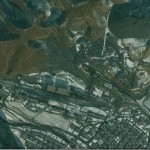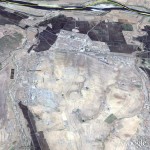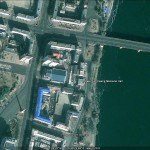UPDATE 1 (2011-1-19): According to the Wall Street Journal:
A Chinese firm has signed a letter of intent to invest $2 billion in a North Korean industrial zone, representing one of the largest potential investments in Kim Jong Il’s authoritarian state and a challenge to U.S. policy in the region.
The agreement was signed with little fanfare in Pyongyang on Dec. 20—a day otherwise marked by pitched tension on the Korean peninsula following the North’s shelling of a South Korean island—according to documents viewed by the Wall Street Journal. Confirmation of the deal comes as Chinese President Hu Jintao visits Washington this week in a bid to forge closer security and economic ties with the U.S.
U.S. officials said the administration is aware of the possible Chinese investment, but noted that previous projects haven’t gone anywhere. “No investment project will enable North Korea to meet the needs of its people as long as its government continues its destabilizing behavior,” said a senior administration official.
The letter of intent involves China’s Shangdi Guanqun Investment Co. and North Korea’s Investment and Development Group. An assistant to the managing director of Shangdi Guanqun, who identified himself only by his surname, Han, said his company’s planned investment is focused on the Rason special economic zone, situated near North Korea’s border with Russia.
The zone was called Rajin-Sonbong when it was established in 1991, but failed to attract sufficient investment. It was revived, and re-named Rason, following a visit there in 2009 by Mr. Kim.
Mr. Han said the plan is to develop infrastructure, including docks, a power plant and roads over the next two to three years, followed by various industrial projects, including an oil refinery, over the next five to 10 years. He said the company was waiting for a response from the North Korean government before applying for approval from China’s Ministry of Commerce.
“It’s all pending at this stage, and it’s really up to the Korean side to make the decision,” Mr. Han said. He added that the $2 billion figure was what the North Korean side had hoped for, not necessarily what his company could deliver.
The company’s Web site says the company was “under the administration” of a state-owned enterprise, Shangdi Purchase-Estate Corporation. Mr. Han, however, said his company was “100 percent private.”
For the Obama administration, securing China’s cooperation in restraining North Korea’s military and nuclear-proliferation activities is a cornerstone of a warmer bilateral relationship. But the potential investment is a reminder of possible limits of Chinese cooperation.
The U.S. wants to step up sanctions to force Kim Jong Il to give up his nuclear-weapons arsenal and military activities. China, meanwhile, is increasingly promoting business projects and direct investment to influence the North, say Chinese and American analysts, arguing financial pressure hasn’t worked.
China is North Korea’s biggest trading partner and aid donor, but the scale of this deal raises concerns in Seoul that Beijing is running its own version of the “Sunshine” policy under which the South boosted investment in the North from 1998 to 2008.
This policy disconnect is expected to be one of the issues Chinese and U.S. officials discuss this week. “These types of deals pursued by China generally present a real challenge to the sanctions” being effective, said Victor Cha, a North Korea expert who helped oversee Asia policy in George W. Bush’s National Security Council. “The net effect is that it does make it more difficult for these sanctions to have the desired effect.”
Such deals have emerged in the past and have come to nothing, analysts said, and it is possible this one, too, could peter out. A number of similar North Korean economic zones have failed to live up to their billing because of poor infrastructure and corruption, and a lack of economic reform. News of the deal was first reported in the Korean-language press, including the Voice of America’s Korean service.
It is unclear how long the agreement has been in the works. But its Dec. 20 signing came on the day South Korea conducted a closely watched artillery test from Yeonpyeong Island near North Korea.
The test marked a high point in tensions after North Korea’s surprise late November shelling of Yeonpyeong, which killed four South Koreans. Pyongyang had threatened a swift military response should Seoul carry out an announced artillery test on Dec. 20. But the day’s drill came and went amid high security in the South, with the North saying in a statement it “did not feel any need to retaliate.”
Top administration officials have recently both praised and chided the Chinese over the North. On a trip to China last week, Defense Secretary Robert Gates commended the Chinese for their “constructive” role in reducing tensions on the peninsula after Pyongyang’s recent shelling of a South Korean island. Secretary of State Hillary Clinton in a Friday speech pressed China to be more aggressive in helping tamp down the North’s nuclear program.
The proposed investment is among the strongest evidence yet of China’s strategy of using direct investment rather political pressure to push for change in North Korea. Chinese experts say that after North Korea’s first nuclear test in 2006, China tried to make improved bilateral relations dependent on Pyongyang dismantling its nuclear program. But after a second test in 2009, China changed tack.
Beijing now believes, according to Chinese experts, that the North Korean regime won’t respond to political pressure and could collapse completely if China cuts off aid and investment, triggering a flood of refugees into northeastern China, and bringing U.S. troops right up to the Chinese border.
The investment strategy was cemented when China’s Premier Wen Jiabao visited North Korea in October 2009 and signed a slew of economic and trade agreements. One of those agreements was for China to fund construction of a $250 million bridge across the Yalu River that separates the two countries.
Construction of the bridge, which would link China with another North Korean special economic zone, had been slated to start in August. Local officials said in November it appeared to have been put on hold indefinitely. Now they say a ground-breaking ceremony was held Dec. 31.
U.S. officials are particularly concerned about how China’s financial links to North Korea may be facilitating Pyongyang’s weapons programs. In November, Pyongyang showed a visiting American scientist 2,000 centrifuges stationed at a cover site, drastically raising fears about the North’s ability to expand its nuclear-weapons arsenal.
“China’s increased economic support undercuts the rest of the region’s efforts to convince Pyongyang that there will be consequences for further belligerence, nuclear weapons development or transfer of nuclear capabilities,” said Michael Green, who also served as a senior official on Asia during the Bush administration.
Read the full story here:
Chinese Firm to Invest in North Korea
Wall Street Journal
Jay Soloman and Jeremy Page
2011-1-19
ORIGINAL POST (2011-1-7): According to the Joong Ang Ilbo:
A Chinese state-run company recently agreed to invest $2 billion in North Korea’s Rason free trade zone, the JoongAng Ilbo learned yesterday from documents related to the deal.
Shangdi Guanqun Investment Co., Ltd. signed a 10-point memorandum of understanding with Pyongyang’s Investment and Development Group on Dec. 20 in Beijing, the documents showed.
The signing ceremony was attended by Mi Chang, president of Shangdi Guanqun Investment, and Kim Chol-jin, president of the Investment and Development Group.
The goal of the investment, stated in the documents, is to build Rason, a northeastern North Korean city on the East Sea that borders both China and Russia, into the “biggest industrial zone in Northeast Asia” in around 10 years.
The project calls for coal-fired power plants, roads, piers and oil refineries in the North Hamgyong Province city, the documents said.
According to the documents, the deal is “a strategic joint project based on trust between high-level figures” in China and North Korea, which suggests it may have been negotiated by North Korean leader Kim Jong-il during two visits to China last year, on which he met Chinese President Hu Jintao.
The North’s economy has suffered under international sanctions on trade and financial services overseas, imposed after its nuclear weapon tests, and is desperately seeking foreign investment.
China is investing in Rason as an export base to serve markets in Japan, southern China and Southeast Asia.
Rason is a merger of two towns, Rajin and Sonbong, and was designated the first free trade zone in the North in 1991. It was promoted to a “special city,” which means it has fewer restrictions on businesses.
“We have a deep interest in North Korea’s ample natural resources,” an official of Shangdi Guanqun Investment Co., Ltd. told the JoongAng Ilbo. “To facilitate the export of natural resources [from the region], we will invest $300 million first and construct a coal-fire power plant at the coal mine and build a railway, roads, and harbors and piers [near it].”
The Chinese firm’s official said the company opened an office in Pyongyang at the end of last month.
Shangdi Guanqun Investment, established in 1995 by the Chinese government, is a trading firm specializing in oil processing, natural resources and international financial services. It is one of the key companies in China’s 12th five-year economic development plan that starts this year.
North Korea’s Investment and Development Group is in charge of developing the country’s four free trade zones. The other economic special zones are in Kaesong, Mount Kumgang and Sinuiju.
The Shangdi Guanqun Investment official said the company will build an oil refinery in Rason, where it plans to refine crude imported from the Middle East and Russia and sell the output to China or other countries.
I believe this Chinese story also relates to the same project.
Read the full story here:
China backs North’s Rason project
Joong Ang Daily
Ko Soo-suk
2011-1-7



